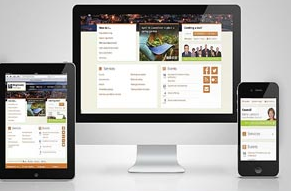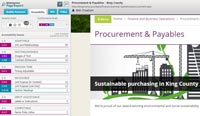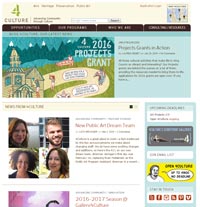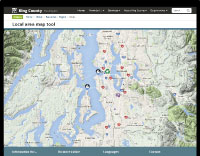Governance, branding and best practices
Creating a consistent user experience that is accessible and mobile friendly
Web authors are expected to read and follow these best practices.
I. Branding for 'One King County' websites
Following the Executive's lead, our governance and standards ensure the public has a consistent, usable and intuitive experience on all kingcounty.gov websites. To do this, eGov provides a framework of standards page templates, tools and design patterns that give you a wide range of design options, while keepiong a consistent look and feel for users.
The .GOV domain extension is strictly controlled. King County is only allowed to have a single .GOV domain name and that is kingcounty.gov.
Why should you want to use it?
- .GOV and .EDU get priority ranking from search engines.
- Users will have the security of knowing they are on a legitimate site.
If you have legitimate business reasons for not wanting to use kingcounty.gov, your site will need to go through an exception request process. This applies to sites that want to use a subdomain (e.g. archivesearch.kingcounty.gov) and sites that will not be managed by Sitecore.
Read more about the .GOV program guidelines.
Standard templates are provided for websites in Sitecore and applications using the masterpage. They provide these advantages:
- Consistent look and feel so visitors know they haven't left the King County site.
- Consistent behavior patterns so it's easier to move through the site and interact with pages and applications.
- Tools such as slide rotators, news feeds, calendars and accordions that make it easier for department staff to effectively communicate with the public through the website.
- Underlying framework vetted and supported by eGov. Faster development time and less maintenance for you.
Template global areas cannot be manipulated
Developers should not remove, restyle, modify, cover or reposition any global element such as the main menu and main footer.
Not only does this detract from the standard King County look, feel, and behavior, it is guaranteed to introduce code conflicts during maintenance and modernization updates.
Custom code, particularly custom styling, is strongly discouraged.
Why it causes problems:
- Custom styling weakens the 'One King County' branding as well as the consistent user experience throughout our website.
- Custom code and custom styling can conflict with the standard tools.
- The standard templates and tools will be tested prior to regular maintenance and updates, custom code will not be.
- Custom code can be costly for an agency to maintain over time:
- Agencies are responsible for maintaining their own custom code. This means keeping code up to date as well as testing and fixing issues during maintenance updates. Agencies can contract with KCIT to create and maintain custom code, but there are support costs in addition to initial implementation.
- The styling we've provided meets accessibility requirements and has already cleared rigorous testing. Deviations from it might not.
Exceptions
Don't use custom code unless it is absolutely necessary to meet your customers' needs. If you need to use custom code, you must go through our exception request process.
KCIT provides a Masterpage template for agencies that have ASP.NET websites and/or applications. This template provides the standard King County website behavior, look and feel. Go to the Masterpage SharePoint site for more details, troubleshooting, and updates.
If you have an ASP.NET application, make sure to subscribe to updates so you will get emails regarding any changes.
In addition to Sitecore, here are KCIT's the approved applications and services:
- GovDelivery (email, newsletters and text messages)
- Socrata (open data)
- Approved social media channels:
- Facebook, Twitter, YouTube, Flickr, Pinterest, Instagram, LinkedIn, Google+, Vimeo, Tumblr, Nextdoor, Periscope
- To request a new social media page, submit a Social Media Action Plan.
- WordPress.com (requires exception request)
- Page Freezer (for archiving)
- Survey Monkey
- Site Improve
- Google Analytics
- Crazy Egg
For more information on any of these tools, please contact the eGov team.
King County’s official logo includes an image of its namesake, the Reverend Dr. Martin Luther King Jr. This original logo design was developed in 2006 with support from both the County Executive and Council, which formally adopted the logo in March 2007.
Use of the new logo will follow the King County Graphic Standards and Guidelines . These standards and guidelines are designed to promote visual consistency, clarity and greater visual recognition of King County government and its services.
These guidelines apply to all materials produced for, by or in partnership with King County. This includes employees and consultants.
To download approved King County logos, visit our logo intranet page .
II. User-centered design and web writing
Agencies should employ user-centered design (UCD) principles when designing their websites. Agencies should use UCD methodology and user-friendly web writing styles.
Responsive webpages
King County's website has seen mobile device use grow from 34% in 2011-12 to 40% in 2015. For many budget-conscious resident, a mobile device is their only way to access kingcounty.gov.
Making our website mobile responsive is a high priority and a key accessibility issue. The Sitecore templates are built so that one webpage will display properly on whatever device the website visitor is using. However, even using standard tools, content might not display in the best way on smaller screens.
Website authors should always test their page designs on multiple screens to make sure the page displays well on small screens.
Effective web writing means putting your most popular content in easy-to-see places and writing text that is in plain language. For specifics, please see King County's Editorial Style Guide.
Web writing is about our audience and what they're trying find find on our site, rather than what we want to tell them. People go to websites to get a question answered, solve a problem or accomplish a task, among other things.
People want to find the information they need in as few clicks as possible. Our job is to make this happen.
How do people read online?
They don't. At least not the way we typically think about how people read online. People rarely read webpages word for word. Instead, they scan the page and pick out individual keywords and short sentences.
Tips for effective web writing
- Write what you think you need and then cut it 50%.
- Embrace white space—don't fill up the entire webpage with text and images.
- Write short sentences; limit paragraphs to 2-3 sentences max.
- Put the important stuff first. Users have little patience for fluffy intro paragraphs or "about us" information.
- Start with the content your audience needs to know, and then follow up with additional details.
- Break up the page with photos, subheads, and bulleted or numbered lists.
- Lastly, don't expect people to read it the way you wrote it.
For federal government websites, writing in plain language is more than good customer service—it's the law.
President Obama signed the Plain Writing Act of 2010 that requires the federal government to use "clear communication the public can understand." King County strives to do the same.
Here are some examples:
- Original
Make sure the account holder's name is the same as the name of the customer to whose account the transaction should be attributed.
Rewritten
Make sure the account is for the right customer.
- Orignal
Retention of tax records for a period of seven years is a requirement for all County residents.
Rerwritten
You must keep all tax records for seven years.
Resources
To help you gauge if your writing is clear enough for the public to understand, you can use these free online tools:
III. Accessibility
Our focus should always be on making information on our website available to any resident who needs it, regardless of whether they have: visual impairments, hearing loss, cognitive impairments, motor skills challenges, etc. We should also be aware of issues for non-native English speakers and users who only have access to small screen (mobile) devices or low bandwidth Internet access. See our Accessibility Top 10.
eGov will provide monthly quality assurance reports through the SiteImprove tool, which includes accessibility issues.
Web editors make corrections when needed and Siteimprove tracks the progress. Design and Civic Engagement Web group provides guidance. If you do not have access to SiteImprove, please request an account.
The proposed new standard for Section 508 is expected to require conformance to the W3C Web Content Accessibility Guidelines (WCAG) 2.0 Level AA. These are a list of resources for guideline information:
- Section 508 checklist
- Section508.gov (Official site)
The Social Security Administration's accessibility help page provides guidelines for top accessibility items.
IV. Security and privacy
All websites must follow security best practices and comply with KCIT security and privacy policies.
If a page on your website or application is requesting any private information like a password, then that user's password needs to be encrypted when they submit it.
Ask the eGov group to set your page as an HTTPS page instead of the default HTTP.
Several requests have been made recently to add Facebook pixels to the King County website. This refers to a code snippet placed on specific Sitecore pages that allow web authors to track “conversions” from Facebook advertisements we place on the social network.
King County's privacy policy clearly states:
- King County may track information, such as user hits, visits and sessions; however this information cannot be linked to a specific person.
- When King County collects personal information from you, we do not sell or make your personal information available to others without your consent except when legally required or permitted by law, or needed to completed your transaction with the county.
- Read King County's privacy policy.
The eGov team can help you use Google Analytics for conversion tracking. The data collected by Google in this case is anonymous and in compliance with county policy.
V. Exception requests
If you wish to deviate from the standards, the following items require committee review:
4Culture website
If you have legitimate business reasons for not wanting to use kingcounty.gov, your site will need to go through an exception request process. This applies to sites that want to use a subdomain (e.g. archivesearch.kingcounty.gov) and sites that will not be managed by Sitecore.
There is a formal exception request process for any site that does:
- Not intend to use kingcounty.gov as it's URL
- Not want to use the standard Sitecore template
- Not wish to be in Sitecore
- Not want to be on King County servers.
Download and submit the exception request form.
For any questions, contact the Web Team.
Future full-width template design
* Coming soon *
Full width templates are a planned future development project
Applications that want to use full-width screens will need to submit a design for four screen sizes: smartphone, tablet, small desktop, and large desktop.
Web authors must demonstrat how the application would respond to screen sizes before they will be approved to use the full screen template (once it is built). These design mockups can be black and white wireframes (hand-drawn, Word, PowerPoint, Visio, Illustrator, Photoshop, or other).

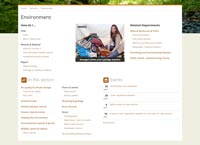

Requests for changes, such as a link on a portal page (e.g. the Animals & Pets page), the main menu, or the main footer, should be submitted via the eGov help request form.
Change requests are evaluated with a user-centered design focus using analytical data. Changes are continually tested and re-evaluated, so they should not be considered permanent.

 Translate
Translate


